Native American Students Build STEM Skills While Exploring Their Cultural Stories with VR/AR Design Projects
A Q&A with Tilanka Chandrasekera
Through a $1.5million, four-year NSF grant, Oklahoma State University researchers are leveraging their earlier work with proven, college-level design courses that incorporate VR, AR, and 3D printing technologies. But this time, they are helping underserved Native American middle school students develop STEM skills.
Here, Campus Technology talks with Principal Investigator Dr. Tilanka Chandrasekera, who is an endowed professor at OSU and director of the Mixed Reality Lab, to find out more about the grant that the NSF titled, "Engaging Native American Students in STEM Career Development Through a Culturally Responsive After School Program Using Virtual Environments and 3D Printing." [NSF award number 2048987]
"We wanted to know if we can use informal learning as a way to develop STEM skills. So, we have created a program through which we are working with after school educators to engage students in projects that incorporate their cultural stories — explored through design thinking and technology tools." —Tilanka Chandrasekera
Mary Grush: I know that for years, you've worked extensively on programs that use VR, AR, 3D printing, and related design tools in your college-level programs and courses at Oklahoma State University. And I know that you've researched how some of those teaching strategies can be applied for elementary through high school students and in some adult communities as well. But now that NSF has awarded your grant program focusing on STEM education for underserved Native American middle school students, you will be able, for the next four years, to do more extensive research on that population — is that right?
Tilanka Chandrasekera: Yes. We've actually worked, in the past, with almost every age or demographic you could name, so you are right: While this work is not new to us, we are now able, through our NSF grant, to focus more of our time and attention on learning more about how to prepare underserved Native American middle school students for STEM education — leveraging and building on what we know about the importance of design thinking, spatial awareness, and cultural relevance.
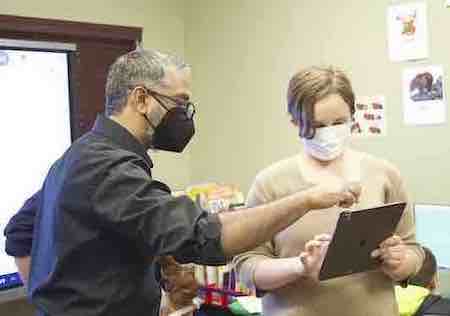
A student uses augmented reality to test out how a digital model of a chair she is designing works in the real-world, surrounding physical space of the classroom.
Grush: What do you want these students to understand, in particular, about VR, AR, and related technologies?
Chandrasekera: Many things, but first of all, what I want to do is to show them how these technologies can be both useful and easy to use. Many of these children have, in the past, been intimidated by technology in general, and they will often tend to move away before even giving it a chance. But VR, AR, and related technologies are not going to be optional in the future of the real world we live in, so we need to prepare these students to work with and to feel very comfortable with technology — and ultimately to move ahead in STEM more generally.
Many of these children have, in the past, been intimidated by technology in general, and they will often tend to move away before even giving it a chance.
Grush: How did you, as the Principal Investigator, and others working on the grant find each other and decide to pursue this?
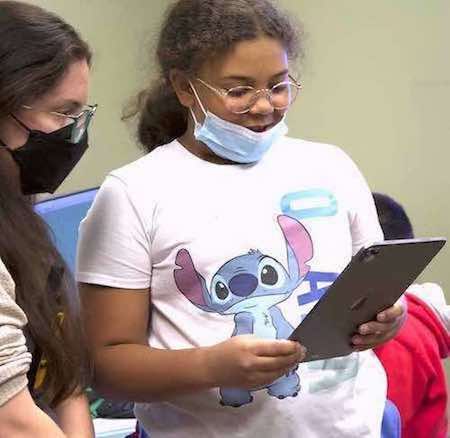
An after school educator looks on as a middle school student uses an iPad to work in augmented reality with 3D interactive models.
Chandrasekera: My co-investigators on the grant, Tutaleni Asino and Nicole Colston, are highly regarded teaching and research colleagues at OSU, both of whom I have had the privilege of knowing for several years. Over the past two years in particular, the three of us were drawn into numerous deep discussions about STEM motivation and preparing students for STEM careers.
With Dr. Asino's expertise in learning, design, and technology in learning contexts, including STEM education; Dr. Colston's impressive track record of outreach to support environmental education and STEM awareness in PK-20; and my own concentration on building curricula and programs for design education with digital technologies; our informal, collegial discussions built momentum quickly and naturally led to an NSF grant proposal.
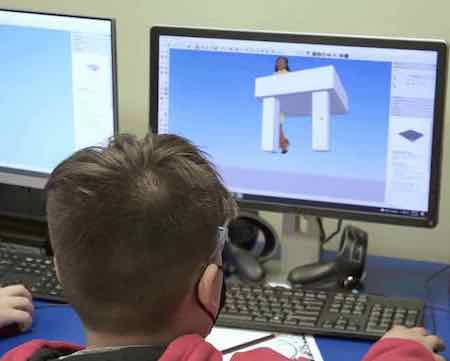
A student starts work on his own 3D model.
Our state of Oklahoma is rich in tribal communities, and we are especially fortunate to have other education colleagues in our region who can support significant aspects of the grant, keeping within the context of Native American culture. Dr. Norma Neely, a tribal elder and member of the Citizen Potawatomi Nation, will help integrate authentic cultural learning into the after school educator workshops. And Dr. Angelina Dayton will work as the external evaluator for this project — her expertise is based on an anthropological assessment of how best to integrate emerging technology into highly structured, low-resourced environments.
Grush: How do you and your colleagues on the grant approach this program?
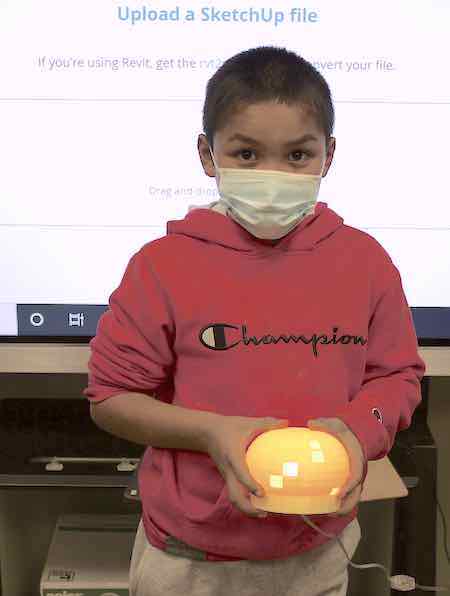
A young after school student modeled his own design of a light fixture using SketchUp, a digital sketch application, then 3D printed his creation, put in the electrical wiring, and proudly shows it here.
Chandrasekera: The way we think of it starts with the idea of space — how and why you design spaces. We asked ourselves: What's the purpose of getting kids together to design spaces?
Our purpose was to develop spatial skills in students, using the technology tools we have for VR, AR, 3D printing, and related design tools. And it's not just visual design — for example, using VR applications, they can "get inside" 3D, spatial objects like motors and learn how they work, literally from inside out. From there, they learn to think in three dimensions. It's important to develop these spatial skills to succeed in STEM education.
It's very beneficial for these young students to move into three dimensional problem spaces as they build their comfort with STEM education — and down the road, their potential to work in STEM fields.
It's very beneficial for these young students to move into three dimensional problem spaces as they build their comfort with STEM education — and down the road, their potential to work in STEM fields.
Grush: Let's get back to the idea of motivation. I know that a big part of the grant program is to make STEM culturally relevant for the students.
Chandrasekera: Native American children have been generally underserved in STEM areas. Cultural relevance is a big part of developing their motivation for moving further ahead in STEM education — so they will select STEM courses in their education pathways going forward.
Native American children have been generally underserved in STEM areas. Cultural relevance is a big part of developing their motivation for moving further ahead in STEM education.
But how do we tap into relevance? We wanted to know if we can use informal learning as a way to develop STEM skills. So, we have created a program through which we are working with after school educators to engage students in projects that incorporate their cultural stories — explored through design thinking and technology tools. The VR, AR, and 3D printing tools that will allow students to tell their stories will help them become more at home with technology.
The VR, AR, and 3D printing tools that will allow students to tell their stories will help them become more at home with technology.
Of course, it's a critical step to develop training modules that will be helpful for the after school educators — so that they learn design thinking in experiential ways that they can draw from as they pass that knowledge on to their students.
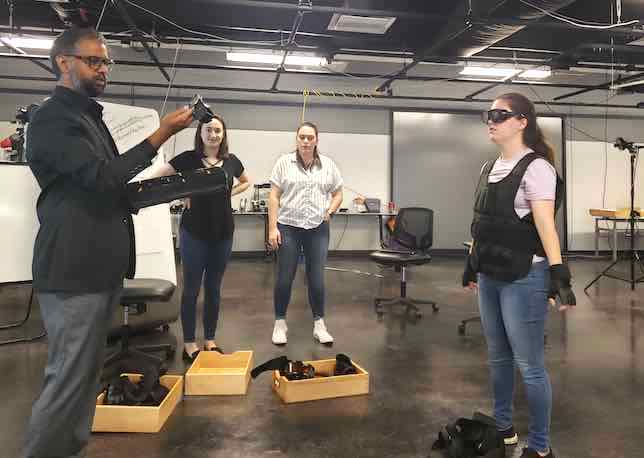
Tilanka Chandrasekera leads an experiential training exercise for the after school educators, focusing on empathic design.
Grush: Who are the students that will be in the after school programs, and how will their cultural stories be incorporated in the informal learning strategies you've designed?
Chandrasekera: The after school educators we trained this past summer will be working throughout the school year with Native American students from the Chickasaw, Pawnee, and Citizen Potawatomi Nation tribes. The students are mostly middle school students though we may include some of the upper elementary students who also attend the after school programs.
Whatever work the after school educators do with these children must be culturally relevant. Let me give you a brief example of how we can tap into that cultural relevance: For the Citizen Potawatomi Nation children — again, this is just one example — we began with their familiar cultural notion of the "Prophecy of the Seven Fires" and aligned our education modules with each of those seven stages. This grounded the students with familiar stories and a sense of place — similar to the idea of genius loci. One of the tasks the children do is to "find an island shaped like a turtle" — an activity that can be supported by rich media experiences and appealing opportunities for the children to be creative with the technology tools. In doing this, we are not simply bringing in alien ideas. We've created a useful context. From there, we can introduce STEM ideas.
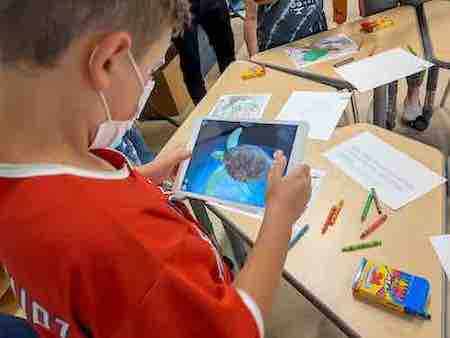
The assignment to "find an island shaped like a turtle" can take a student through a series of rich media experiences — often leading to the student's first opportunity to be creative using technology tools.
For the after school educators, we've explained that this is "generative design" — specifically, in this case, offering a cultural context in which to present STEM ideas. Over the course of our four years on the grant, we'll have plenty of examples of generative design, and many lessons learned about exactly what works and what doesn't.
Grush: And as for the students, are you hopeful that they will learn to use the technology tools in ways that are relevant to them — will they be able to use these tools going forward?
Chandrasekera: Absolutely. We are encouraging them, all the time, to use the tools in the technology centers established at their schools by the grant, to explore and express ideas that are meaningful in their own lives. And after the students have more experience with the tools, we will be organizing a "mini hackathon," in which students will work in small groups to solve problems they and their peers have themselves identified.
It's not about "Learn the technology." It's about "Now you can use the technology to do something good."
[Editor's note: Images courtesy Oklahoma State University.]